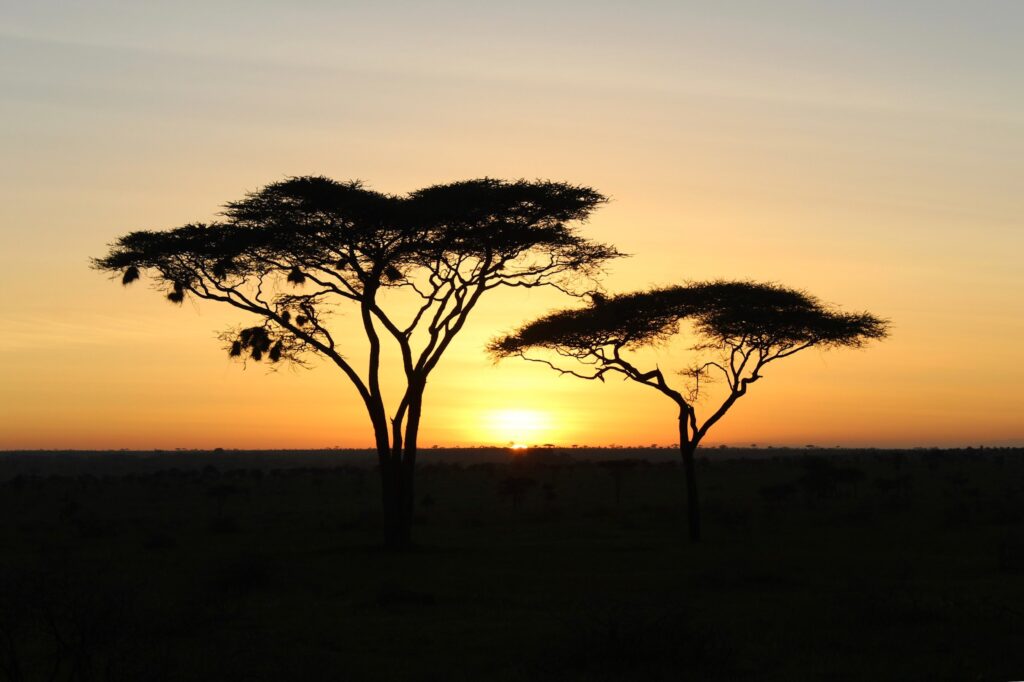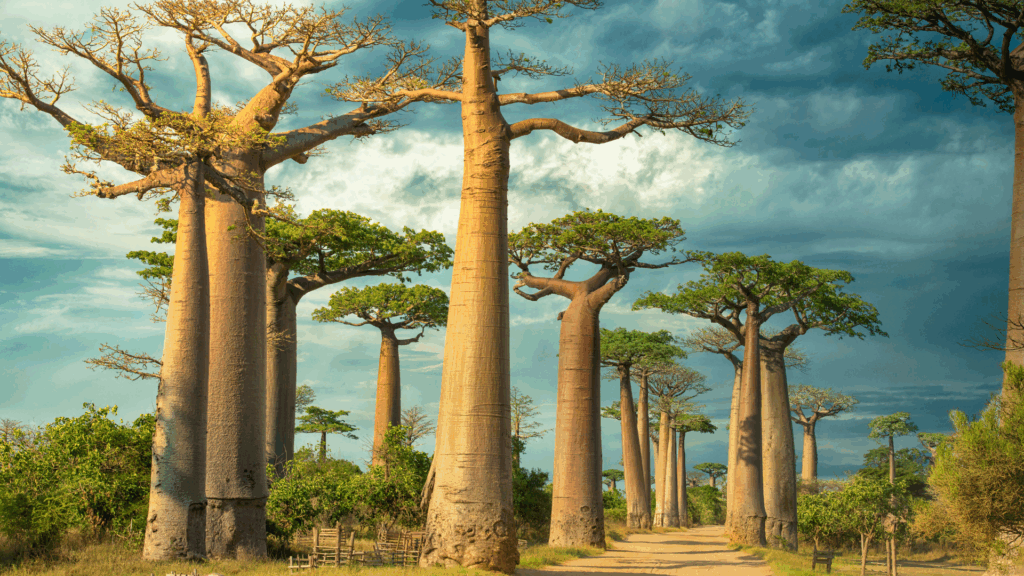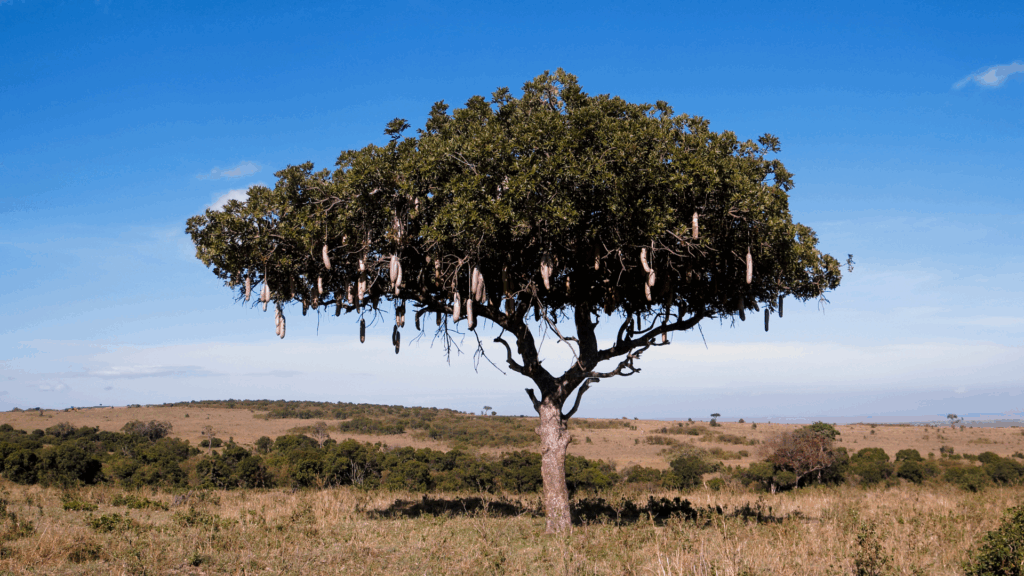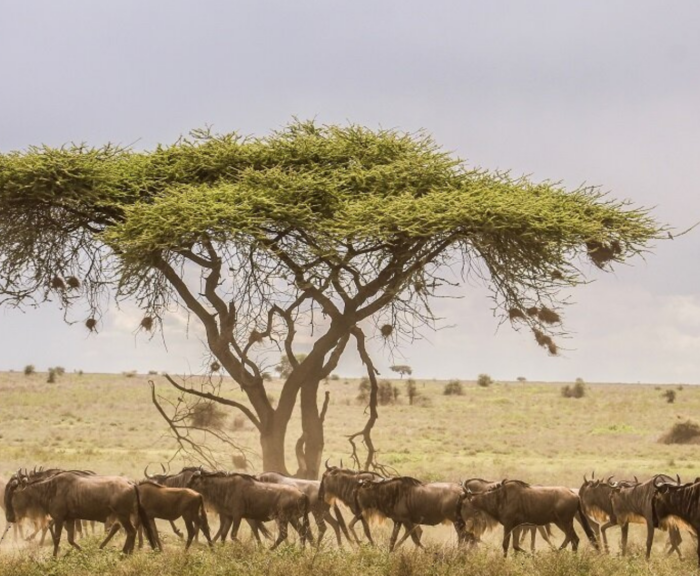The Serengeti is known for its Great Migration, predators, and open plains. But the foundation of this ecosystem is its trees and savanna plants.
From baobabs that store water to acacias that feed giraffes, these plants support wildlife in many ways. Grasslands cover most of the region, providing food for wildebeest, zebras, and gazelles and shaping their migration.
For safari travelers, nature lovers, and conservationists, knowing about these trees and plants adds to the safari experience.
Here’s a look at the key trees, grasses, and shrubs that make up the Serengeti.

Why Trees Are Crucial in the Serengeti
Trees are essential to Serengeti National Park, providing food, water, and shelter for wildlife while maintaining the ecosystem’s balance.
How Trees Shape the Ecosystem
- Regulate the climate by providing shade and moisture retention.
- Prevent soil erosion, especially near riverbanks and slopes.
- Act as food sources for herbivores, primates, birds, and insects.
Wildlife and Trees – A Vital Connection
- Baobabs store water, helping elephants survive droughts.
- Acacias provide crucial food for giraffes.
- Fig trees support entire ecosystems, feeding birds, monkeys, and bats.
Serengeti trees have evolved unique survival mechanisms, including:
- Water storage (Baobabs hold thousands of liters).
- Thorns and toxins (Acacias and Euphorbias deter overgrazing).
- Fire resistance (Thick bark and rapid regrowth after wildfires).
The Most Iconic Trees of the Serengeti
1. The Baobab Tree (Adansonia digitata) – “The Tree of Life”


Where to Find It
- Found in central Serengeti, particularly near rocky outcrops (kopjes).
- Common in Tarangire National Park (outside Serengeti), where elephants frequently interact with them.
How It Supports Wildlife
- Massive water storage: Stores thousands of liters of water (120,000) inside its spongy trunk, making it a lifeline during droughts.
- A wildlife magnet:
- Elephants strip their bark for moisture.
- Baboons and birds feast on its nutrient-rich fruit.
- Bats pollinate its large, night-blooming flowers.
Best Season to See It
- Year-round: Its massive trunk is distinctive even when leafless.
- Fruiting season: Between March and May, when its vitamin-packed “monkey bread” fruit ripens.
How to Identify It on Safari
- Look for: A gigantic trunk, often hollow inside, with branches resembling roots reaching skyward.
Interesting Fact: Some baobabs are estimated to be over 2,000 years old!
Cultural Significance
- Traditional uses: The bark, fruit, and leaves are used in African medicine to treat fevers, infections, and digestive issues.
- Local beliefs: Some cultures believe the baobab was planted upside-down by the gods as a form of punishment!
2. The Umbrella Thorn Acacia (Vachellia tortilis) – “The Classic Savanna Tree”


Where to Find It
- Widespread across the Serengeti, particularly in open plains and woodland edges.
- Often seen near waterholes where herbivores gather.
How It Supports Wildlife
- Giraffes’ favorite snack:
- Its tiny leaflets and thorny branches make it a perfect high-browse food source.
- Shade provider:
- Lions and cheetahs rest under its broad canopy.
- Elephants often gather beneath its dense shade to escape the midday sun.
- Seed pods:
- Consumed by elephants, zebras, and gazelles.
- Dung beetles help disperse seeds, aiding tree regeneration.
Best Season to See It
- Wet season (Nov–May): When it has lush green leaves.
- Dry season (June–Oct): Pods mature and drop, feeding herbivores during food shortages.
How to Identify It on Safari
- Look for: A flat-topped canopy, tiny leaflets, and long white thorns.
Did You Know?
When giraffes overgraze one acacia, the tree releases tannins into its leaves and sends an airborne warning to nearby trees, causing them to do the same!
3. The Sausage Tree (Kigelia africana) – “The Curious Fruit Bearer”


Where to Find It
- Prefers riverbanks and swampy areas, commonly seen in western Serengeti and around the Mara River.
How It Supports Wildlife
- Huge, sausage-shaped fruits:
- Hippos, baboons, and elephants eat the fruit, which falls from the tree.
- The fruit can weigh up to 7 kg (15 lbs)!
- Tree of predators:
- Leopards often rest in their sturdy branches after a hunt.
- Bats and nocturnal pollination:
- The tree’s red, bell-shaped flowers open at night, attracting fruit bats.
Best Season to See It
- Dry season (June–Oct): Fruits are more visible, hanging like giant sausages from long stems.
How to Identify It on Safari
- Look for: Large, hanging fruits, deep red flowers, and twisted branches.
Fun Fact: The fruit is poisonous when raw, but locals use it in traditional medicine and beer brewing!
4. The Whistling Thorn (Vachellia drepanolobium) – “The Tree with an Army”


Where to Find It
- Thrives in dry savanna areas, especially in central and southern Serengeti.
How It Supports Wildlife
- Defense alliance with ants:
- The tree’s hollow thorns house biting ants that attack anything that tries to eat it.
- Giraffes browse carefully, using their long, prehensile tongues to avoid the ants.
- Elephant-resistant:
- Unlike other acacias, elephants avoid this tree due to its aggressive ant defenders.
Best Season to See It
- Visible year-round, though greener in the wet season (Dec–May).
How to Identify It on Safari
- Look for: Ball-shaped thorns with small holes (ant nests).
Did You Know?
The wind passing through the hollow thorns creates a whistling sound, giving the tree its name!
5. The Yellow Fever Tree (Vachellia xanthophloea) – “The River Giant”


Where to Find It
- Prefers wetland areas, commonly seen along Grumeti River and Mara River.
How It Supports Wildlife
- Shade provider: Hippos, crocodiles, and birds rest beneath its cool shade.
- Pollinator-friendly: Bees, butterflies, and birds are drawn to its flowers.
Best Season to See It
- Wet season (Nov–May): Its bright yellow-green bark contrasts with fresh foliage.
How to Identify It on Safari
- Look for: A tall tree with smooth, yellow-green bark and long white thorns.
Interesting Fact: Early settlers believed it caused malaria, but it only thrives where malaria-carrying mosquitoes live!
6. The African Myrrh (Commiphora africana) – “The Aromatic Healer”
Where to Find It
- Grows in eastern Serengeti and rocky areas.
How It Supports Wildlife
- Elephants strip their bark to access nutrient-rich resin.
- Birds use its gnarled branches for nesting.
Best Season to See It
- Dry season (June–Oct), when its unique peeling bark is visible.
How to Identify It on Safari
- Look for: Peeling, papery bark with a strong fragrance.
Fun Fact: Its resin is used for traditional medicine and perfumes.
7. The Wild Date Palm (Phoenix reclinata) – “The Serengeti’s Oasis Provider”


Where to Find It
- Found in swamps, rivers, and waterholes, especially in western Serengeti.
How It Supports Wildlife
- Lions and leopards rest under its shady fronds.
- Birds feast on its small dates.
Best Season to See It
- Wet season (Nov–May), when its lush fronds create a tropical look.
How to Identify It on Safari
- Look for: Tall, arching fronds and small date fruits.
Fun Fact: It’s one of the few native palms in the Serengeti!
8. The Candelabra Tree (Euphorbia ingens) – “The Poisonous Beauty”


Where to Find It
- Commonly found in dry woodlands and rocky areas of the Serengeti and Ngorongoro Conservation Area.
- Often grows on kopjes (rocky outcrops), providing shade for small animals.
How It Supports Wildlife
- Provides shade and shelter:
- Found near rocky outcrops where leopards and hyraxes rest.
- Birds, such as hornbills, nest in its thick, spiny branches.
- Toxic latex discourages herbivores:
- Its white, milky sap is highly toxic to most animals.
- However, certain caterpillars and insects feed on the leaves without harm.
Best Season to See It
- Visible year-round due to its evergreen, thick succulent branches.
- Flowering season: Late dry season (Aug–Oct), when small yellow-green flowers appear.
How to Identify It on Safari
Look for:
- Tall, green, cactus-like branches resembling a candelabra.
- No leaves, only thick segmented stems with small flowers at the tips.
Interesting Fact: Despite looking like a cactus, it is NOT a true cactus; it belongs to the Euphorbia family. Its toxic latex can cause skin burns and blindness if it touches the eyes!
Cultural Significance
- Used in traditional African medicine in extremely small doses to treat parasites.
- In some communities, the latex was historically used as a poison for hunting arrows.
9. The Sycamore Fig (Ficus sycomorus) – “The Lifesaving Fig Tree”


Where to Find It
- Grows near riverbanks, swamps, and moist valleys in northern Serengeti and along the Mara River.
- Also found among kopjes, where its roots break through rocky cracks in search of water.
How It Supports Wildlife
- A year-round fruit provider:
- Elephants, monkeys, and birds rely on its figs for nutrition, especially in dry seasons.
- Fruit bats and hornbills spread its seeds over large distances.
- Home for countless animals:
- Monkeys and leopards use its large branches for climbing and resting.
- Bees and insects pollinate its small flowers hidden inside the fig.
Best Season to See It
- Year-round, it produces fruit continuously, unlike many other trees.
- Most abundant fruiting occurs during the wet season (Nov–April).
How to Identify It on Safari
Look for:
- Smooth, grayish bark that often peels in patches.
- Large, buttressed roots (especially near water sources).
- Bright green, broad leaves and clusters of yellow-orange figs.
Interesting Fact: It has a unique pollination system, where each species of fig tree is pollinated by its own species of tiny wasp!
Cultural Significance
- Considered sacred in many African cultures.
- The fig fruit is eaten by humans and has been used in traditional medicine for digestion and healing wounds.
The Savanna Plants That Sustain Life: Serengeti’s Nutrient Powerhouse
Serengeti’s plants provide food, protect the soil, and support wildlife. They survive fires, droughts, and grazing, ensuring a stable ecosystem.
1. Red Oat Grass (Themeda triandra) – “The Fuel of the Great Migration”
Key Role: The primary grazing grass for wildebeest, zebras, and gazelles, providing essential nutrients for migrating herds.
Where to Find It:
- Dominates the Serengeti Plains, especially in central and southern regions.
- Grows in both wet and dry seasons, ensuring a continuous food supply.
Adaptations:
- Fire-resistant – Regrows quickly after wildfires.
- Drought-tolerant – Deep roots access underground moisture.
- Fast-growing – Ensures year-round grazing availability.
Best Season to See It:
- Wet season (Nov–May): Green and lush.
Dry season (June–Oct): Turns golden-brown, fueling migration.
2. Elephant Grass (Pennisetum purpureum) – “The Giant of the Grasslands”


Key Role: Provides dense cover for small animals and serves as a primary food source for elephants and hippos.
Where to Find It:
- Found near rivers, swamps, and floodplains, especially in western Serengeti and along the Mara River.
Adaptations:
- Rapid regrowth – Survives heavy grazing.
- Dense growth – Helps retain moisture in dry conditions.
- Fibrous structure – Provides high-energy forage for large herbivores.
Best Season to See It:
- Wet season (Nov–May): Grows tall and green.
Dry season (June–Oct): Found in water-rich areas.
3. Spear Grass (Heteropogon contortus) – “Nature’s Velcro Seed”


Key Role: A soil-stabilizing species with sharp, spiral-shaped seeds that attach to animals for dispersal.
Where to Find It:
- Common in semi-arid areas and woodland edges, mixed with taller grasses.
Adaptations:
- Drought-resistant – Deep roots access underground water.
- Seed dispersal strategy – Hooks onto animals’ fur for transport.
Best Season to See It:
- Wet season (Nov–May): Green and palatable.
- Dry season (Aug–Oct): Sharp seeds become visible.
These hardy plants sustain the Serengeti’s herbivores, influence migration patterns, and support predators by maintaining prey populations. Without them, the entire ecosystem would collapse.
The Tough and Thorny Shrubs of the Serengeti
While grasses and trees dominate the landscape, shrubs play a crucial role in the Serengeti ecosystem. These hardy plants stabilize soil, provide food for wildlife, and recover quickly after fires or grazing.
1. Sickle Bush (Dichrostachys cinerea)
Key Role: A fast-growing, fire-resistant shrub that improves soil fertility and provides forage for herbivores.
Where to Find It:
- Common in woodland edges and disturbed areas across the Serengeti.
How It Supports Wildlife:
- Elephants and giraffes browse its leaves and bark.
- Its roots enrich the soil by fixing nitrogen.
Adaptations:
- Fire-resistant – Regrows rapidly after wildfires.
Drought-tolerant – Deep roots access underground moisture.
2. White Raisin Bush (Grewia bicolor)
Key Role: A multi-purpose shrub that provides food, shade, and medicinal benefits.
Where to Find It:
- Found in dry woodlands and savanna regions.
How It Supports Wildlife:
- Elephants and birds feed on its leaves and berries.
- Bushbuck and impalas browse its foliage.
Adaptations:
- Drought-resistant – Survives harsh conditions with deep roots.
- Medicinal use – Used by local communities for stomach ailments and wound healing.
These shrubs are essential for maintaining biodiversity, offering food, shelter, and ecological stability in the ever-changing Serengeti landscape.
How These Plants Survive the Serengeti
Plants in the Serengeti face intense heat, prolonged droughts, wildfires, and heavy grazing. To survive, they have evolved remarkable adaptations.
- Fire Resistance: Some grasses and shrubs, like Red Oat Grass and Sickle Bush, regrow quickly after wildfires.
- Water Storage: The Baobab Tree is a natural reservoir, holding thousands of liters of water in its trunk.
- Thorns as Defense: Whistling Thorn Acacia protects itself with stinging ants that deter herbivores.
- Deep Roots for Drought Survival: The African Myrrh Tree draws moisture from deep underground, thriving even in dry seasons.
- Fast Regeneration: Many Serengeti plants have thick bark, underground root reserves, or leaf modifications to survive harsh conditions.
- Animal-Plant Relationships: Trees and plants depend on wildlife for seed dispersal, pollination, and natural pruning.
These adaptations ensure that even in the most extreme conditions, Serengeti’s plant life supports its diverse wildlife.
Conservation Challenges and How Tourists Can Help
Threats to Serengeti’s Flora
- Deforestation: Expanding human settlements and agriculture threaten native trees.
- Overgrazing: Livestock in buffer zones compete with wildlife for vegetation.
- Climate Change: Unpredictable rainfall patterns disrupt plant growth and seed production.
Ongoing Conservation Efforts
- Protected National Park Status helps limit illegal tree-cutting.
- Tree-planting initiatives aim to restore degraded landscapes.
- Sustainable land management prevents soil erosion and maintains biodiversity.
- Choose eco-friendly safari operators that follow conservation guidelines.
- Avoid damaging vegetation—don’t break branches or step on fragile plants.
- Support local conservation projects through donations or responsible tourism.
By making sustainable choices, visitors can help protect the Serengeti’s trees, grasses, and shrubs for future generations.
Serengeti Trees: The Silent Guardians of the Wild
The Serengeti’s trees and plants are just as important as its wildlife. They provide food, shelter, and stability to the entire ecosystem, supporting everything from grazing herds to top predators.
Next time you’re on safari, take a moment to look beyond the animals—notice the towering baobabs, the thorny acacias, and the endless golden grasses that make life here possible.
Want to see it all up close? Join a safari and experience the true magic of the Serengeti’s flora and wildlife together.
FAQs About Serengeti Trees and Savanna Plants
1. What are some common savanna plant names found in the Serengeti?
The Serengeti is home to a variety of savanna plants, including Red Oat Grass, Elephant Grass, Spear Grass, Sickle Bush, and White Raisin Bush. These plants are essential for feeding grazing animals and maintaining the ecosystem.
2. What is the oldest tree in Tanzania?
One of the oldest trees in Tanzania is the African Baobab (Adansonia digitata), which can live for over 2,000 years. These trees are found in Serengeti National Park and serve as water reservoirs for wildlife.
3. What types of trees grow in grasslands?
Trees in grasslands are typically drought-resistant and adapted to open landscapes. In the Serengeti, common species include Umbrella Thorn Acacia, Whistling Thorn, and the Sausage Tree, which provide food and shelter for animals.
4. What type of soil is in the Serengeti?
The soil in the Serengeti was formed by volcanic ash, making it nutrient-rich with high levels of sodium, calcium, and potassium. However, the soil is shallow, leading to the formation of caliche, a hard, calcareous layer beneath the surface.
5. Where can I find a Serengeti plain map?
A Serengeti Plain map can be found at visitor centers in Serengeti National Park, through official Tanzanian tourism websites, or on digital platforms like Google Maps. The map shows key areas like grasslands, woodlands, and migration routes.
6. What is the difference between the Serengeti plain and the savanna woodlands?
The Serengeti plain consists of vast, open grasslands with scattered trees, while savanna woodlands have a mix of grass and denser tree cover, found mostly in the northern and western Serengeti.
7. What is Serengeti National Park famous for?
Serengeti National Park is famous for the Great Migration, where millions of wildebeest, zebras, and gazelles travel across its plains. It is also known for its diverse wildlife, iconic trees, and breathtaking landscapes.
8. What is the vegetation in the Serengeti?
The vegetation in Serengeti National Park is mainly savanna, which includes grasslands, plains, marshes, woodlands, and kopjes. The term savanna refers to semi-arid land ranging from open grasslands to tree-dotted woodlands, creating a diverse and balanced ecosystem.
9. What fruits grow in the Serengeti?
Several wild fruits grow in Serengeti National Park, including those from the Wild Date Palm, commonly found near swamps and rivers. While its fruits are edible but bitter, its sap can be fermented into palm wine, a traditional drink in some regions.
10. What is the national tree of Tanzania?
The national tree of Tanzania is the African Blackwood (Dalbergia melanoxylon), commonly found in the Miombo woodlands of southern Tanzania and northern Mozambique. Known for its dense, durable wood, it is highly valued and serves as a symbol of the country.





